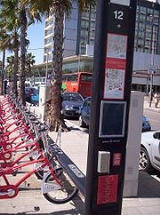
Bicing
Encyclopedia
Bicing is the name of a 'community bicycle program
' in Barcelona
inaugurated on March 22, 2007, similar to the Vélô service in Toulouse, Vélo'v
in Lyon
and Vélib'
in Paris
, and apparently uses the same system and bicycles as Stockholm City Bikes
. Its purpose is to cover the small and medium daily routes within the city in a climate friendly
way, almost without pollution (especially the emission of finest particulate matter), roadway noise
, traffic congestion
and to reclaim the urban streets with non-polluting vehicles
.
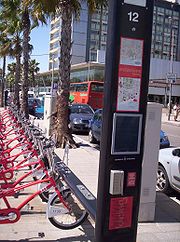
manage and maintain the system. To use it, users must acquire a yearly membership. Currently the network consists of more than 400 stations to lend and return over 6000 bicycles distributed throughout the system. The stations are situated through most of the flat areas of the city with a distance of around 300 to 400 metres between each one, with many situated next to public transport stops to allow for intermodal use
. Metro
Stations usually have signs pointing to the locations of nearest Bicing stations.
The bikes can be lent from, and returned to, any station in the system, making it suitable for one way travel. Each station has between 15 and 30 parking slots to fix and lock the bicycle.
 To rent a bike one simply swipes the contactless RFID-card at a service station to be personally identified by the system, which then unlocks a bike from the support frame. Bicycles can be used for the first 30 minutes with no extra cost, with subsequent half hour blocks (up to 2 hours) costing 0.50 € each. Use of a bicycle for more than 2 hours at a time is discouraged with a penalty rate of 3 € per hour, but also with the possibility of having your membership cancelled after a certain number of uses in excess of 2 hours. To return a bicycle one simply places the bike in a spare slot at a Bicing station: the bike is recognised automatically and is locked into place (as indicated by the small light at the slot turning red), so one does not need to swipe the RFID-card to return the bike. Nevertheless users are encouraged to swipe the card to receive a system message that the returned bike has been correctly recognized as the small red light sometimes give erroneous signals.
To rent a bike one simply swipes the contactless RFID-card at a service station to be personally identified by the system, which then unlocks a bike from the support frame. Bicycles can be used for the first 30 minutes with no extra cost, with subsequent half hour blocks (up to 2 hours) costing 0.50 € each. Use of a bicycle for more than 2 hours at a time is discouraged with a penalty rate of 3 € per hour, but also with the possibility of having your membership cancelled after a certain number of uses in excess of 2 hours. To return a bicycle one simply places the bike in a spare slot at a Bicing station: the bike is recognised automatically and is locked into place (as indicated by the small light at the slot turning red), so one does not need to swipe the RFID-card to return the bike. Nevertheless users are encouraged to swipe the card to receive a system message that the returned bike has been correctly recognized as the small red light sometimes give erroneous signals.
Specialised vans are used to redistribute Bicing bicycles between the stations should it be required to even out usage patterns. However, as of November 2007, the number and frequency of vans is not able to keep up during the peak hours, making it very difficult to find a spot at which to return the bike.
The Bicing member cards are only sent to addresses in Catalonia in an attempt to prevent tourists from using the system. This limitation was imposed upon the City Council by pre-existing local bike hire companies (grouped under Bicitours) that feared what they called illicit competition from the Bicing system. Bicitours and City Council agreed as well in enforcing a user block of ten minutes to change bikes (that is, when docking a bike, the user is blocked for ten minutes before being able to leave with another bike). As a result tourists are barred from using what is officially denominated a "public transport system" - a bit like barring tourists from using the metro or buses.
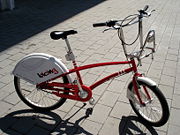 The bike is specially designed to prevent theft of parts, or of the whole bike, as well as to prevent vandalism. It is also designed to be easily recognised.
The bike is specially designed to prevent theft of parts, or of the whole bike, as well as to prevent vandalism. It is also designed to be easily recognised.
Bikes have sometimes been stolen, even sawing the anchors that fix bikes on the stands, and found repainted.
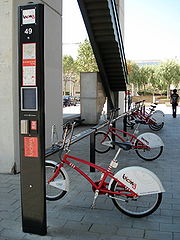 The spaces for the parking stations have mostly been freed from car or motor-cycle parking spaces, with a small percentage of stations being placed on large pedestrian areas.
The spaces for the parking stations have mostly been freed from car or motor-cycle parking spaces, with a small percentage of stations being placed on large pedestrian areas.
service.
The system is also paid for a very expensive 902 number - as most users will be calling from mobiles when they need customer service, the price of ringing the 902 number can be very expensive, thus bringing in more income for Bicing.
, Eixample
and some parts of Sant Martí
and Gràcia
. As of November 2007 the system had been used more than 2,750,000 times, representing 8,000,000 km of travel.
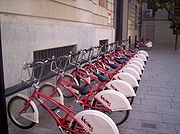 The bike sharing system was received by the inhabitants with great enthusiasm, covering approximately 70% of the city area, except areas with slopes of more than 4% and the hilly area of Montjuic
The bike sharing system was received by the inhabitants with great enthusiasm, covering approximately 70% of the city area, except areas with slopes of more than 4% and the hilly area of Montjuic
and Tibidabo
. Several neighboring
cities
have asked to extend the service to their city as well and studies are underway on how to implement this for the flatter part of the wider metropolitan area
.
used for jogging
), parking (car park), camping (campsite) and vueling, which is a Catalan
airline. Due to the hybrid nature of this Spanglish neologism, few of Bicing's English-speaking users can agree on how to pronounce it.
Community bicycle program
A bicycle sharing system is a service in which bicycles are made available for shared use to individuals who do not own them. Bicycle sharing systems can be divided into two general categories: "Community Bike programs" organized mostly by local community groups or non-profit organizations; and...
' in Barcelona
Barcelona
Barcelona is the second largest city in Spain after Madrid, and the capital of Catalonia, with a population of 1,621,537 within its administrative limits on a land area of...
inaugurated on March 22, 2007, similar to the Vélô service in Toulouse, Vélo'v
Vélo'v
Vélo'v is a bicycle rental service run by the city of Lyon, France, in conjunction with the advertising company JCDecaux. The relationship with JCDecaux allows the city to provide the service on a cost neutral basis for the city, and at very low cost to users, in return for providing exclusive...
in Lyon
Lyon
Lyon , is a city in east-central France in the Rhône-Alpes region, situated between Paris and Marseille. Lyon is located at from Paris, from Marseille, from Geneva, from Turin, and from Barcelona. The residents of the city are called Lyonnais....
and Vélib'
Vélib'
' is a large-scale public bicycle sharing system in Paris, France. Launched on 15 July 2007, the system has expanded to encompass over 20,000 bicycles and 1,202 bicycle stations, located across Paris and in some surrounding municipalities...
in Paris
Paris
Paris is the capital and largest city in France, situated on the river Seine, in northern France, at the heart of the Île-de-France region...
, and apparently uses the same system and bicycles as Stockholm City Bikes
Stockholm City Bikes
Stockholm City Bikes is the name of a public-private partnership project of Stockholm in Sweden and the outdoor advertising unit of Clear Channel Communications....
. Its purpose is to cover the small and medium daily routes within the city in a climate friendly
Sustainable transport
Sustainable transport refers to any means of transport with low impact on the environment, and includes walking and cycling, transit oriented development, green vehicles, CarSharing, and building or protecting urban transport systems that are fuel-efficient, space-saving and promote healthy...
way, almost without pollution (especially the emission of finest particulate matter), roadway noise
Roadway noise
Roadway noise is the collective sound energy emanating from motor vehicles. In the USA it contributes more to environmental noise exposure than any other noise source, and is constituted chiefly of engine, tire, aerodynamic and braking elements...
, traffic congestion
Traffic congestion
Traffic congestion is a condition on road networks that occurs as use increases, and is characterized by slower speeds, longer trip times, and increased vehicular queueing. The most common example is the physical use of roads by vehicles. When traffic demand is great enough that the interaction...
and to reclaim the urban streets with non-polluting vehicles
Human-powered transport
Human-powered transport is the transport of person and/or goods using human muscle power. Like animal-powered transport, human-powered transport has existed since time immemorial in the form of walking, running and swimming...
.

Operation
The city council and Clear ChannelClear channel
A clear-channel station is an AM band Radio station in North America that has the highest protection from interference from other stations, particularly concerning night-time skywave propagation. Usually known as class A stations since 1982, they are occasionally still referred to by their former...
manage and maintain the system. To use it, users must acquire a yearly membership. Currently the network consists of more than 400 stations to lend and return over 6000 bicycles distributed throughout the system. The stations are situated through most of the flat areas of the city with a distance of around 300 to 400 metres between each one, with many situated next to public transport stops to allow for intermodal use
Intermodal passenger transport
Intermodal passenger transport involves more than one mode of transport of passengers. Some modes of transportation have always been intermodal; for example, most major airports have extensive facilities for automobile parking and have good rail or bus connections to the cities nearby. Urban bus...
. Metro
Barcelona Metro
The Barcelona Metro , part of the public transportation system of Barcelona, Catalonia, is an extensive network of electrified railways that run underground in central Barcelona and above ground into the city's suburbs. Since July 31, 2010, Barcelona Metro system consists of 11 lines with 165...
Stations usually have signs pointing to the locations of nearest Bicing stations.
The bikes can be lent from, and returned to, any station in the system, making it suitable for one way travel. Each station has between 15 and 30 parking slots to fix and lock the bicycle.

Specialised vans are used to redistribute Bicing bicycles between the stations should it be required to even out usage patterns. However, as of November 2007, the number and frequency of vans is not able to keep up during the peak hours, making it very difficult to find a spot at which to return the bike.
Subscription
To use the system you must become a member. Subscription to the system is possible through the Bicing website (www.bicing.com), or through visiting the service office. The provision of a credit card number is necessary. It takes ten days to receive your card.The Bicing member cards are only sent to addresses in Catalonia in an attempt to prevent tourists from using the system. This limitation was imposed upon the City Council by pre-existing local bike hire companies (grouped under Bicitours) that feared what they called illicit competition from the Bicing system. Bicitours and City Council agreed as well in enforcing a user block of ten minutes to change bikes (that is, when docking a bike, the user is blocked for ten minutes before being able to leave with another bike). As a result tourists are barred from using what is officially denominated a "public transport system" - a bit like barring tourists from using the metro or buses.
The smart bike

Theft and vandalism
Common user complaints include missing ringbells, cut brakes, and poor maintenance.Bikes have sometimes been stolen, even sawing the anchors that fix bikes on the stands, and found repainted.
The stations

Financing of System
The system is paid for mostly by local car drivers with an effective on street parking control distributed throughout a large part of the densely populated inner-city. This money is then used to pay 2.23 million € annually to the system operator for a period of ten years. The yearly user fee is 35€ with tax included, which makes it the city's cheapest public transportPublic transport
Public transport is a shared passenger transportation service which is available for use by the general public, as distinct from modes such as taxicab, car pooling or hired buses which are not shared by strangers without private arrangement.Public transport modes include buses, trolleybuses, trams...
service.
The system is also paid for a very expensive 902 number - as most users will be calling from mobiles when they need customer service, the price of ringing the 902 number can be very expensive, thus bringing in more income for Bicing.
Usage statistics
The sharply increased rate after 2 hours of continued use ensures each individual bike is used between 10 and 15 times a day by different people. More than 95% of the rides are shorter than 30 minutes. When a bicycle is returned it is necessary to wait 10 minutes before taking another one, again for free. Although there are over 90,000 registered users as of September 2007 only 1/3 of them are using the system on a regular basis. So far the network extends through Ciutat VellaCiutat Vella
Ciutat Vella is a district of Barcelona, numbered District 1. The name means "old city" in Catalan and refers to the oldest neighborhoods in the city of Barcelona, Spain. Ciutat Vella is nestled between the Mediterranean Sea and the neighborhood called l'Eixample...
, Eixample
Eixample
The Eixample is a district of Barcelona between the old city and what were once surrounding small towns , constructed in the 19th and early 20th centuries....
and some parts of Sant Martí
Sant Martí
Sant Martí , is a district of Barcelona located on its eastern side, usually numbered 10 out of the ten districts of the city.It borders the Mediterranean sea, Sant Adrià del Besòs and four other districts of the city: Ciutat Vella, l'Eixample, Horta-Guinardó and Sant Andreu.It did not become an...
and Gràcia
Gràcia
Gràcia is a district of the city of Barcelona, Catalonia, Spain. It comprises the neighborhoods of Vila de Gràcia, Vallcarca i els Penitents, El Coll, La Salut and Camp d'en Grassot i Gràcia Nova. Gràcia is bordered by the districts of Eixample to the south, Sarrià-Sant Gervasi to the west and...
. As of November 2007 the system had been used more than 2,750,000 times, representing 8,000,000 km of travel.
Planned future expansion

Montjuïc
Montjuïc is a hill located in Barcelona, Catalonia.-Etymology:Montjuïc is translated as 'Jew Hill' in medieval Catalan, or is perhaps related to the Latin phrase Mons Jovicus . The name is found in several locations in the Catalan Countries: the Catalan cities of Girona and Barcelona both have a...
and Tibidabo
Tibidabo
Tibidabo is a mountain overlooking Barcelona, Catalonia, Spain. At 512 meters it is the tallest mountain in the Serra de Collserola. Rising sharply to the north-west, it affords spectacular views over the city and the surrounding coastline....
. Several neighboring
Badalona
Badalona is a city in eastern Catalonia, Spain. It is located in the comarca of the Barcelonès, near the city of Barcelona and part of its metropolitan area. It is situated on the left bank of the small Besòs River and on the Mediterranean Sea, backed by the Serra de la Marina mountain range...
cities
L'Hospitalet de Llobregat
L'Hospitalet de Llobregat or briefly L'Hospitalet is a city to the immediate southwest of Barcelona in Catalonia, Spain, and the second largest in Catalonia by population...
have asked to extend the service to their city as well and studies are underway on how to implement this for the flatter part of the wider metropolitan area
Barcelonès
Barcelonès is the most economically important comarca of Catalonia, Spain. Its capital is Barcelona, which is also the capital of Catalonia.- Municipalities :Population figures are for 2009 .-External links:* *...
.
Name
The name is derived from bici short Catalan and Spanish form for bicycle and the Airport code for Barcelona which is BCN. As well the English continuous ending of -ing is used for other means of transport in Spanish like footing (a pseudo-anglicismPseudo-Anglicism
Pseudo-anglicisms are words in languages other than English which were borrowed from English but are used in a way native English speakers would not readily recognize or understand. Pseudo-anglicisms often take the form of portmanteau words, combining elements of multiple English words to create a...
used for jogging
Jogging
Jogging is a form of trotting or running at a slow or leisurely pace. The main intention is to increase fitness with less stress on the body than from faster running.-Definition:...
), parking (car park), camping (campsite) and vueling, which is a Catalan
Catalonia
Catalonia is an autonomous community in northeastern Spain, with the official status of a "nationality" of Spain. Catalonia comprises four provinces: Barcelona, Girona, Lleida, and Tarragona. Its capital and largest city is Barcelona. Catalonia covers an area of 32,114 km² and has an...
airline. Due to the hybrid nature of this Spanglish neologism, few of Bicing's English-speaking users can agree on how to pronounce it.
See also
- Utility cycling - Short-term hire schemes
- Bike sharing

